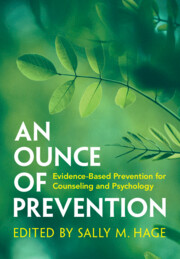Book contents
- An Ounce of Prevention
- An Ounce of Prevention
- Copyright page
- Dedication
- Contents
- Figures
- Contributors
- Acknowledgments
- Part One A Foundation in Prevention
- Part Two Prevention with Children and Youth
- Part Three Prevention with Emerging Adults
- Part Four Across the Lifespan: Adults and Families
- Part Five Closing
- Index
- References
Part Four - Across the Lifespan: Adults and Families
Published online by Cambridge University Press: 14 November 2024
- An Ounce of Prevention
- An Ounce of Prevention
- Copyright page
- Dedication
- Contents
- Figures
- Contributors
- Acknowledgments
- Part One A Foundation in Prevention
- Part Two Prevention with Children and Youth
- Part Three Prevention with Emerging Adults
- Part Four Across the Lifespan: Adults and Families
- Part Five Closing
- Index
- References
- Type
- Chapter
- Information
- An Ounce of PreventionEvidence-Based Prevention for Counseling and Psychology, pp. 237 - 334Publisher: Cambridge University PressPrint publication year: 2024

